
 |
|||||
|
|
|||||
|
|
|
|||||
|
|
 |
SCOTCH BRIDGET First recorded in 1851, this is a Scottish culinary apple. It is also widely grown in Northumberland, Yorkshire, Lancashire, Westmorland and Cumberland. A middle/late season, medium sized apple, ripe in October and storing until the year end. Apples are roundish, broad at the base, narrowing at the apex, where ribs end in a knobbed eye cavity. The skin is greenish yellow, with brownish or bright red patches, almost totally covering the surface towards the sun. The cooked apples soften slowly and keep their shape, with a nicely sweet flavour, not particularly acid or tangy, but pleasantly gentle. Though not very juicy, the apples are also enjoyable eaten raw if fully ripe or kept a while. Trees have striking, striped blossom. T*. Pollination Group 4 |
||
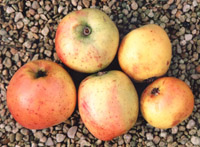 |
SCOTCH DUMPLING An old, favoured Scottish cooking apple, which entered the National Fruit Trials in 1949, though it is much older. It probably originated in the Clydesdale area. A middle season apple in milder areas, which can be used as early as August, before it is ripe, and which will store to November. A medium to large apple, varying from oval to slightly conical and broadly ribbed. The pale green skin turns yellow and often develops a pinkish red flush. The flesh is fine and acid, cooking to a froth. Trees have deep buds and attractive blossom. Our thanks to John and Helen Hempsall for sending scion wood to us. Pollination Group 4 |
|||
 |
SERGEANT
PEGGY Raised by F.W. Wastie of Eynsham, Oxfordshire in 1922 by
crossing Blenheim Orange and Gloria Mundi. It was named by his son, J.F.
Wastie, after his own wife. The culinary apple is large, lightly ribbed,
slightly conic, sometimes flat, greenish yellow and mostly striped with
light crimson. The flesh is firm, creamy white, subacid and has a pleasing
mellow flavour when cooked, keeping its shape. When fully ripe it is quite
pleasant to eat raw, initially having a slight bitterness that fades with
storing. Ripe in October it will keep to January, with care. Attractive
dark pink buds. Pollination Group 3 |
|||
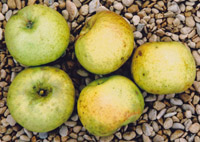 |
SHARLSTON
PIPPIN The true Sharlston Pippin, from Sharlston, Nr Wakefield,
West Yorkshire. Brief references to it often mis-spell the name as Sharleston
or Charleston. This was given to us by the Gilmour family who were given
a tree by the then head gardener of Cannon Hall, Barnsley, who had a tree
growing in his private garden. Mr William N. Gilmour had called to collect
a vine cutting for a friend’s fruit collection and, while walking
around, the head gardener said (Mr Gilmour reports) ““I bet
your friend does not have that apple, that is Sharlston Pippin a true
Yorkshire variety from near Wakefield” and without more ado cut
off several lengths of scionwood for me”. The head gardener reported
that there were still several Sharlston Pippins growing around Wakefield.
The apples have pale golden skin, when ripe, and russet dots, with variable
light russeting elsewhere. The flesh is firm, juicy and fragrant, with
a refreshing taste. Medium sized and middle to late season. A report from
John Southall of Wakefield says that his grandfather had a tree in the
1880s, giving the first known date. We have now had the pleasure of returning
Sharlston Pippin back to its home at Cannon Hall. Ripe in September, it
remains sweet, crisp and juicy into December, softening somewhat, but
still keeping a rich flavour. Pollination Group 5 |
|||
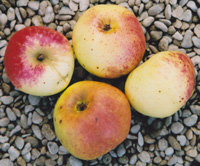 |
SHERBET
STOAT The Polecat Public House, at Prestwood, Buckinghamshire,
contained several old and interesting apples in its extensive orchard
garden, and we took scions of all, with the permission of the former owner,
John Gamble, in 2005. Unfortunately the new owners have removed most of
the trees to enlarge the car park.The fruits bore all the hallmarks of
varieties planted to provide both food and cider for the old Inn’s
guests. The trees were at least a century old and many very old. We have
named them after the Mustelid family of creatures. Sherbet Stoat is primarily
an eating apple, though it will cook, keeping its shape and with a good
sweet flavour, though perhaps losing some richness. As an eating apple
it is delicious when fully ripe at the end of September or early October.
The flesh is crunchy and crisp, with juice positively bouncing out, and
sweet and rich with just the right amount of lemony acid. The flavour
is like sherbet at the back of the throat. Pollination Group 4. |
|||
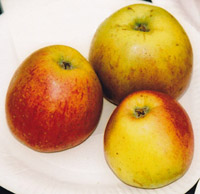 |
SHILLING
A dual-purpose apple, known at Dymock in Gloucestershire in the early
1900s. Medium to large fruit, conical in shape, with pronounced ribs which
end in an undulating eye basin. The fruit has a very short, fat stalk.
The skin is green with red stripes and there is a red cheek on the side
near the sun. Crisp, juicy flesh, with a slight tang, which is pleasant
to eat raw. The fruit keeps its shape when cooked, and has a good rich
flavour. Ripe in September, the apples will store until November. The
blossom has striking dark buds. Pollination Group 4 |
|||
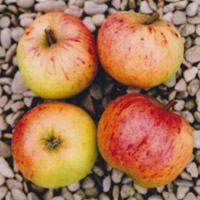 |
SHUSTOKE
APPLE An old variety and a truly ancient tree. In 2005, a casual
enquiry to us from Keith Bostock, farmer of Shustoke, Warwickshire, prompted
us to ask him if he had ever heard of, or encountered, the long lost Shustoke
Pippin. It was listed in the London Horticultural Society catalogues of
1826, 1831 and 1842, was listed by Scott in 1872 but was not known to
Hogg in 1884. It has not been seen since. All that is known is that it
was a medium sized, flat, yellow apple with a red flush, sharp tasting
and late season. Shustoke is a small village, with a community of farms,
rural and unspoilt, squeezed between the sprawling Birmingham and Coventry.
Keith Bostock knew of an old tree on the edge of the former grounds of
Shustoke Hall, a large ancient moated house, remote and surrounded by
farmland. Very interested in old fruit varieties, he kindly brought us
apples, scionwood and photos of the tree. We visited the tree and were
hugely impressed. The size, condition and location all point to a very
ancient survivor. It is 2 feet wide, hollow, supported only by thin strands
of living bark, now short yet still growing and fruiting. The apples are
not identifiable as any variety named and known today and match all the
brief description of Shustoke Pippin, though we may not assume it is the
same. The apples are small to medium, irregular, round, with a stout stalk,
knobbed and set obliquely in a sheathed, often webbed, cavity. They are
obscurely ribbed, accentuated at the eye, with pronounced sepals. The
eye is closed in a shallow puckered basin Early on, the skin is pale green,
flecked paler green, with pink and deeper pink dots and flecks. When fully
ripe it develops an amber/red flush and a few scarlet stripes. The flesh
is coarse and hard until fully ripe in October, when it becomes juicy
and develops a good flavour, more sharp than sweet, but rich. Pollination
Group 5 |
|||
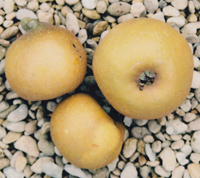 |
SIDDINGTON
RUSSET Discovered in 1923 at the nursery of John Jefferies and
Sons at Siddington, Gloucestershire, as a sport of Galloway Pippin. A
culinary and dessert apple of medium to large size, flattened round, with
yellow skin overlaid with golden russet. The russet is sometimes complete
and quite scaly. To eat raw, the apples are not that juicy and a little
soft, but have a rich, sweet flavour. When cooked the apple keeps its
shape and has a pleasant, sweet flavour. Ripe in October, the fruit will
last into the next year. Dark buds and blossom. Pollination Group 5 |
|||
|
||||